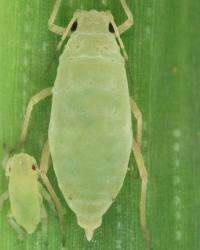New tool for tracking a voracious pest

Since it first appeared in Texas in 1986, the Russian wheat aphid has cost U.S. wheat growers an estimated $200 million each year. But U.S. Department of Agriculture (USDA) scientists have developed a new tool to keep track of this nasty worldwide threat to wheat and barley and to provide guidance to researchers and plant breeders on control strategies.
Gary Puterka, who is with the Agricultural Research Service (ARS) Wheat, Peanut and Other Field Crops Research Unit in Stillwater, Okla., and his colleagues have developed a system that uses DNA "barcodes" to identify emerging biotypes of Russian wheat aphids that threaten wheat and other cereal crops. In DNA barcoding, scientists sequence a designated part of an organism's genome and produce a barcode from it for a systematic comparison with the sequenced DNA of other closely related species.
ARS is USDA's chief intramural scientific research agency, and this research supports the USDA goal of promoting agricultural sustainability.
Russian wheat aphids have been controlled by resistant wheat varieties, but the appearance of a new biotype that overcame resistance in 2003 has forced growers to rely on insecticides while breeders develop new, resistant varieties. Monitoring of Russian wheat aphid populations for the emergence of new biotypes is important because researchers and breeders need to know resistant crops being developed will be effective against emerging biotypes.
Aphid species typically produce eggs in the fall and place them in wheat and wild grass leaves. The eggs of various aphid species are often placed together and that makes locating new biotypes difficult. Puterka and Kevin Shufran, a former ARS scientist who recently retired from the Stillwater unit, have developed a way to tell them apart.
The researchers extracted DNA from the eggs of 10 previously identified species of aphids, including several of the Russian wheat aphid's closest relatives, and sequenced a variable part of the CO1 mitochondrial gene. In a blind experiment, Shufran compared DNA from eggs of species provided by Puterka, who masked their identities. Through genetic analyses, Shufran was able to DNA barcode the different aphid species. This will greatly improve their effort in locating new biotypes. Results were published in Annals of the Entomological Society of America.
More information: April 2012 issue of Agricultural Research magazine
Provided by Agricultural Research Service

















